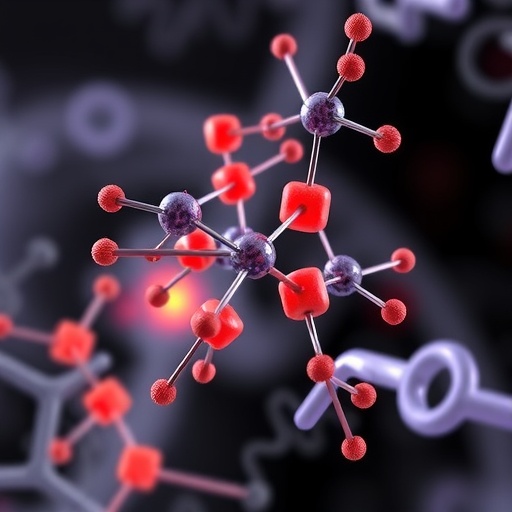Recent advancements in the field of anti-inflammatory therapy have showcased a potential breakthrough in the fight against chronic inflammatory diseases. A research team led by García-Yagüe and colleagues has proposed a novel inhibitor targeting the interaction between β-TrCP1 and NRF2, a mechanism that may transform therapeutic strategies for various inflammation-related disorders. Chronic inflammation is known to underlie a range of diseases, from autoimmune disorders to metabolic syndromes, making the discovery of effective inhibitors a major focus for biomedical research.
The study utilizes sophisticated molecular techniques to explore the interaction between β-TrCP1, an E3 ubiquitin ligase, and NRF2, a transcription factor vital for cellular defense against oxidative stress. This interaction is crucial as it regulates the stability of NRF2, which in turn modulates the expression of antioxidant genes. By inhibiting this interaction, the researchers aim to restore the function of NRF2, enhancing the cell’s response to oxidative stress and inflammation.
The research meticulously outlines the structural biology of the β-TrCP1/NRF2 interaction, emphasizing the pivotal role of specific amino acid residues that mediate this binding. Through an innovative approach combining molecular docking simulations and biochemical assays, the team developed a small-molecule inhibitor that effectively disrupts the binding affinity between these two proteins. The successful identification of such an inhibitor not only extends our understanding of protein interactions in inflammatory pathways but also opens avenues for therapeutic development.
In vitro experiments demonstrated that the novel inhibitor significantly enhances NRF2 stability, leading to elevated levels of antioxidant response genes. The findings indicate that by stabilizing NRF2, this inhibitor can effectively mitigate the effects of pro-inflammatory cytokines, providing relief in several inflammatory models. These results highlight the inhibitor’s potential as a therapeutic agent, suggesting that it could be integrated into treatment regimens for various inflammatory conditions.
What elevates this research is the detailed characterization of the inhibitor’s efficacy and specificity. The researchers conducted thorough pharmacological studies to assess the compound’s selectivity against similar protein-interacting partners. Such specificity is crucial for minimizing off-target effects and ensuring that the therapeutic benefits are achieved without unwanted side effects.
Further analysis involved assessing the inhibitor’s impact on cellular signaling pathways associated with inflammation. The team reported that treatment with the β-TrCP1/NRF2 interaction inhibitor resulted in a notable reduction in markers of inflammation in mouse models. This suggests that the compound not only benefits individual cells but can also potentially quell systemic inflammation, a hallmark of chronic diseases.
The implications of this research are far-reaching as they pave the way for developing targeted anti-inflammatory therapies. The ability to specifically inhibit the β-TrCP1/NRF2 interaction opens a new frontier in understanding how modulation of this pathway can lead to improved treatment strategies. Moreover, the versatility of the compound could see it applied across a range of inflammatory diseases, from rheumatoid arthritis to neurodegenerative disorders, where inflammation plays a critical role.
As the scientific community rallies around the findings, collaborations are likely to emerge aimed at further optimizing the compound for clinical use. Future studies could explore the long-term effects of this inhibition and how it interacts with existing treatment modalities. Additionally, investigating its pharmacokinetics and potential toxicological profiles will be essential to advancing this research from bench to bedside.
Moreover, this work reinforces the significance of NRF2 in not only inflammation but also broader metabolic processes. By elucidating the regulatory mechanisms that govern NRF2 stability, researchers can further appreciate its role in various diseases, fostering a holistic view of cellular stress responses. This integrative perspective is crucial when developing comprehensive treatment strategies that address multiple pathways simultaneously.
The growing interest in targeted therapies underscores a paradigm shift in treating chronic diseases, where precision medicine becomes ever more attainable. Such advancements are particularly salient given the increasing prevalence of inflammatory conditions worldwide. Enhanced understanding of β-TrCP1/NRF2 interactions may also facilitate the identification of biomarkers that enable clinicians to predict patient responses to therapy, moving towards a more personalized approach in medicine.
As the paper continues to circulate within academia and industry, anticipations for further research and clinical trials will undoubtedly build. The confluence of innovative science and practical application signifies an exciting time for therapeutic development in anti-inflammatory treatments. Scientists and pharmaceutical developers alike will benefit from the insights gained from this research, ultimately impacting patient care and treatment outcomes.
In closing, García-Yagüe and colleagues have embarked on a significant journey that not only uncovers the intricacies of β-TrCP1 and NRF2 interactions but also heralds a new era in the fight against inflammation. The ramifications of their findings extend beyond molecular biology, promising to reshape therapeutic landscapes as we strive to understand and conquer chronic inflammatory diseases. As further validation and development of their inhibitor unfolds, the hope is that this discovery will lead to tangible improvements in the quality of life for patients suffering from inflammatory conditions.
Subject of Research: Novel β-TrCP1/NRF2 interaction inhibitor for anti-inflammatory therapy
Article Title: A novel β-TrCP1/NRF2 interaction inhibitor for effective anti-inflammatory therapy
Article References: García-Yagüe, Á.J., Cañizares-Moscato, L., Encinar, J.A. et al. A novel β-TrCP1/NRF2 interaction inhibitor for effective anti-inflammatory therapy. J Biomed Sci 32, 65 (2025). https://doi.org/10.1186/s12929-025-01157-3
Image Credits: AI Generated
DOI: https://doi.org/10.1186/s12929-025-01157-3
Keywords: β-TrCP1, NRF2, anti-inflammatory therapy, chronic inflammation, molecular docking, small-molecule inhibitor, oxidative stress, therapeutic development, precision medicine, biomarkers.




